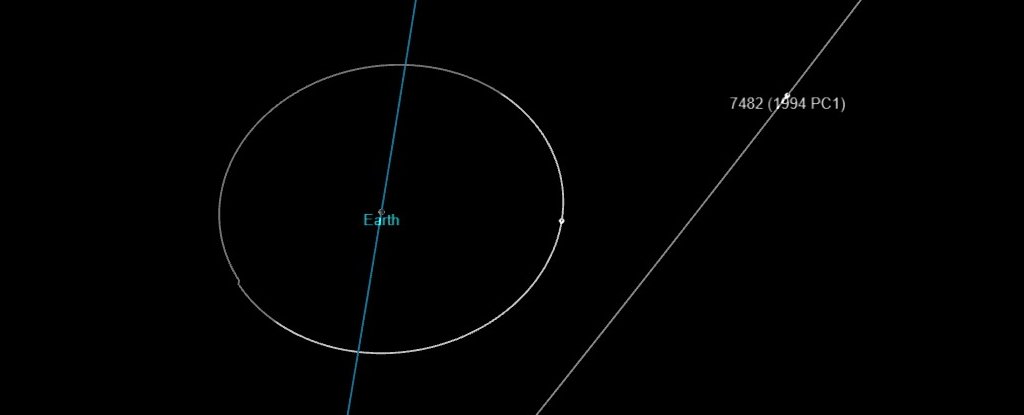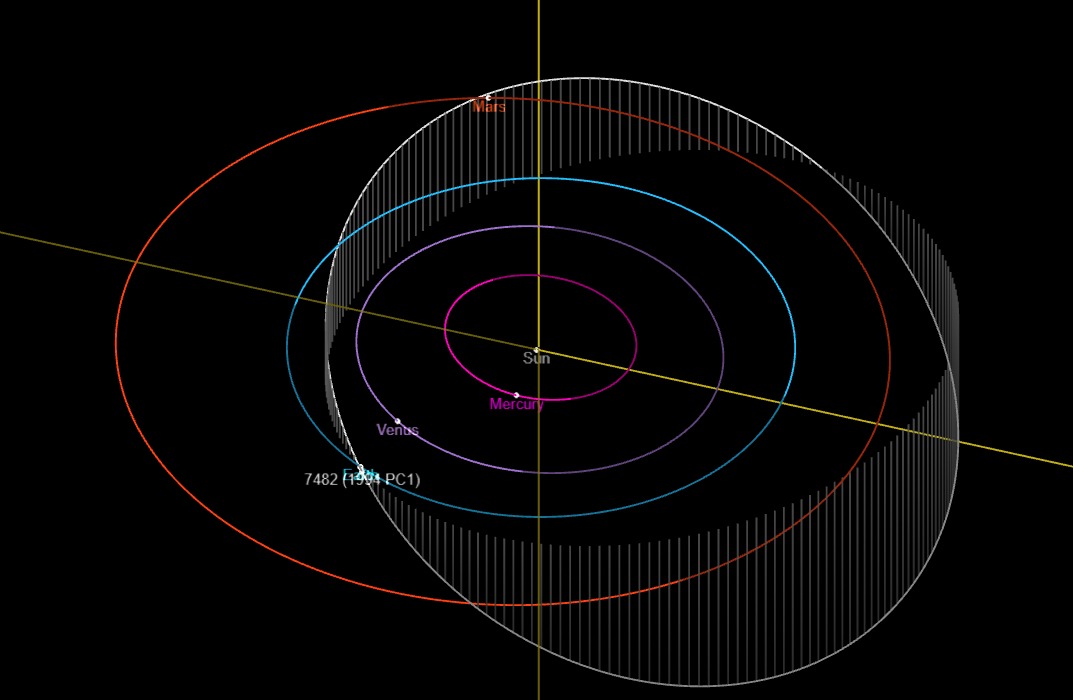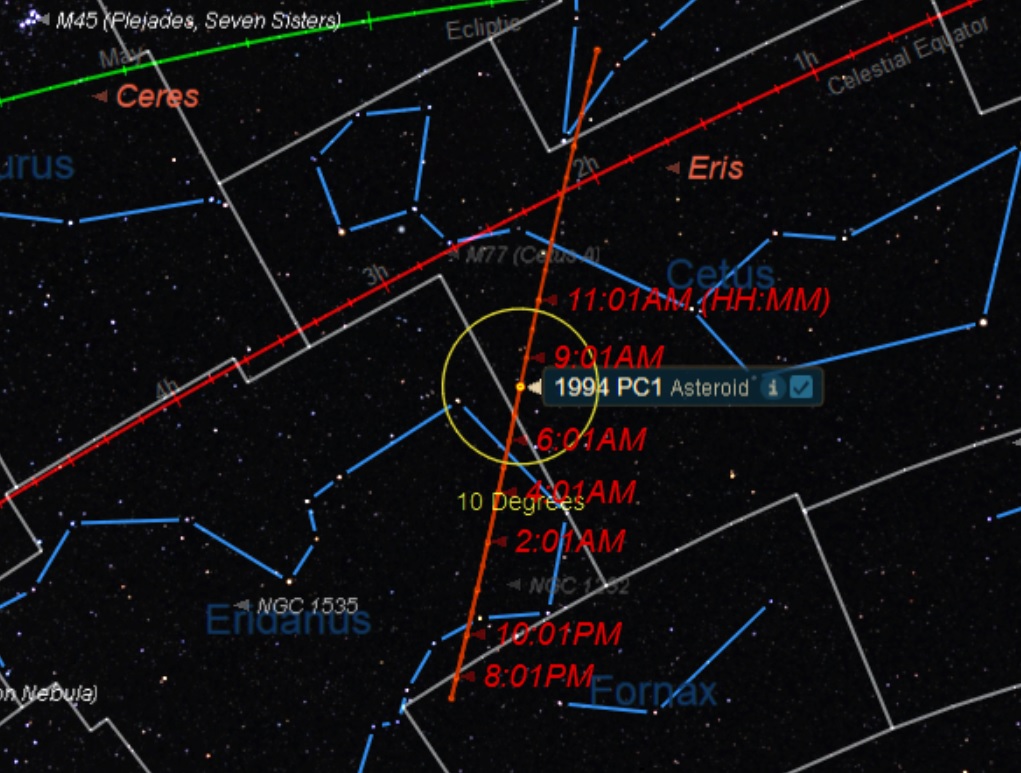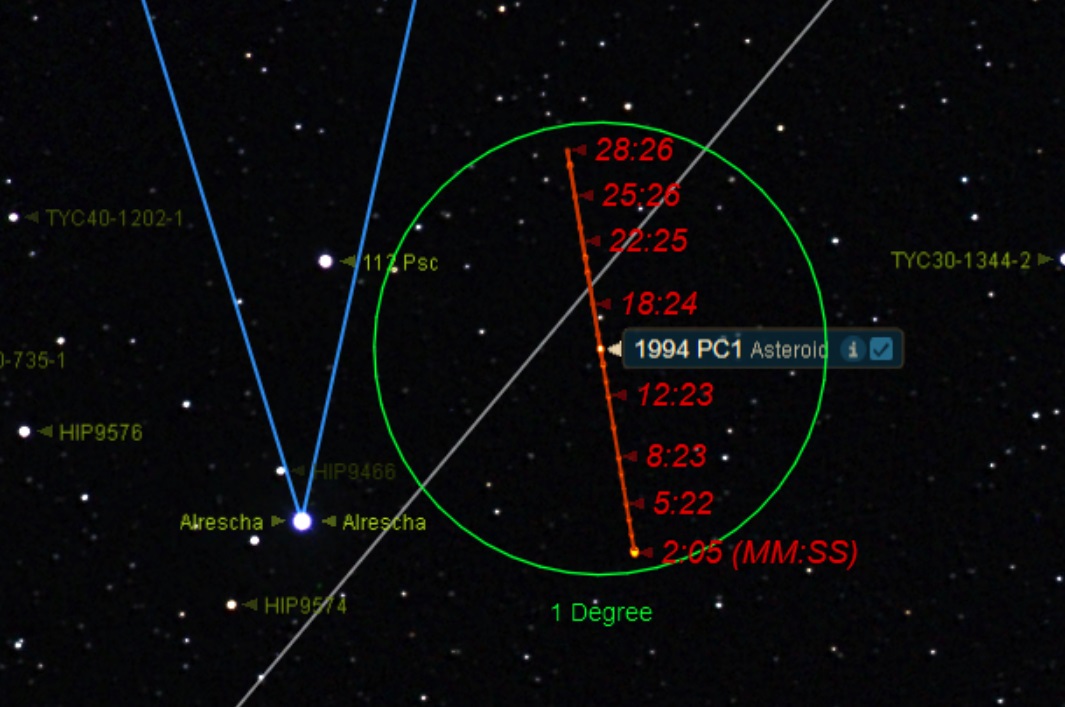
Posted on 01/18/2022 6:18:01 AM PST by Red Badger

The asteroid's orbit gets quite close to our moon's. (NASA/JPL)
**************************************************************************
In a slow-moving universe, asteroids give us a rare chance to see things moving in real time. We have such a chance coming right up on the evening of Tuesday, January 18th, when 1.1-kilometer asteroid (7482) 1994 PC1 passes 1.23 million miles (1.98 million kilometers) from Earth.
This is about five times the distance from Earth to the Moon, and just a shade over the distance to the anti-sunward Earth-Sun Lagrange 2 point, soon to be the home of the James Webb Space Telescope.
Fortunately, both Earth and said space telescope are safe from the asteroid on this pass, and will remain so for centuries into the foreseeable future. The asteroid was discovered on the night of August 9th, 1994 by astronomer Robert McNaught observing from the Siding Spring Observatory.
The Apollo asteroid is an Earth-crosser, with a perihelion interior to our own at 0.9 Astronomical Units (AU) from the Sun, and an aphelion out in the asteroid belt at 1.8 AU, with an orbital period of 572 days. It's orbital inclination of 33.5 degrees relative to the ecliptic makes it pass far from Earth on most years.
Near-Earth #asteroid 1994 PC1 (~1 km wide) is very well known and has been studied for decades by our #PlanetaryDefense experts. Rest assured, 1994 PC1 will safely fly past our planet 1.2 million miles away next Tues., Jan. 18.
Track it yourself here: https://t.co/JMAPWiirZh pic.twitter.com/35pgUb1anq
— NASA Asteroid Watch (@AsteroidWatch) January 12, 2022 Fun fact: looking back through sky plates, 1994 PC1 actually turns up in images all the way back to 1974.
1994 PC1 is a S-class stony-type asteroid, and is only slightly larger than another well-known NEO asteroid, 101955 Bennu, the target of NASA's Osiris-Rex sample return mission, which returns to Earth with its precious cargo late next year.
This week's pass is the closest for the asteroid since January 17, 1933 (pre-discovery) at 0.00752 AU, and the closest for the next two centuries, although the pass on January 18, 2105 is nearly as close, at 0.01556 AU.

The orbit of asteroid 1994 PC1. (NASA/JPL)
************************************************************************************
Hunting the Asteroid
This week's close approach gives observers a chance to see the asteroid for themselves.
At its closest on the night of January 18th at 21:51 Universal Time (UT), 1994 PC1 will be straddling on the Cetus/Pisces border and moving at a blistering 2 degrees an hour (spanning a section of sky four times the size of tonight's Full Moon, per hour) or 2 arc minutes a minute.
That's fast enough to see the motion of the speedy asteroid versus the starry background after watching it at the eyepiece for just a minute or two. At its brightest, 1994 PC1 should flirt with magnitude +9 or so, making it easily visible with a small telescope or perhaps, binoculars.
I remember the thrill of seeing asteroid 4179 Toutatis on its close pass in 2004. That passage was very similar to this week's, watching as the space rock silently crept across the starry background.
The good news is, you can start hunting for 1994 PC1 tonight: the asteroid is still a respectable +12th magnitude plus on either evening before or after closest approach, January 17th or January 19th. Also, unlike closer passes, parallax versus observer location won't play too much of a factor in the asteroid's true position in the sky.
To catch it, you'll need a telescope capable of precisely pointing at coordinates in right ascension and declination. You can get these ephemerides for your time and location by inputting '1994 PC1' at NASA/JPL Horizons site.
The night of Monday, January 17th finds asteroid 1994 PC1 low to the south at dusk on the border of the southern hemisphere constellations of Fornax and Eridanus. Tough, though not an impossible target for North American observers.
The key night of Tuesday, January 18th sees the asteroid making its closest pass by Earth for this century. Standing on the surface of the asteroid Tuesday night, you'd see the Earth as a 22' half-full disk, slightly smaller than a full moon.

RedFlightPathOfAsteroidOnStarMap 24-hour path of asteroid for January 18th, in one hour increments. (Starry Night)
***********************************************************************************
Though the precise time of closest approach favors Africa and European longitudes, North America also gets a good look at dusk. Another good approach to tracking the asteroid is to know when it's going to pass near a bright star, stake out the position, and watch at the appropriate time.
Once such opportunity occurs in the hours around 21:05 UT Tuesday night, when 1994 PC1 passes 43' from the +3.8 magnitude star Alrescha (Alpha Piscium).

StarMapShowingLocationFeaturesAndPathOfAsteroidInRed Close-up of pass near Alrescha (Alpha Piscium) from 21:02 to 21:29 UT. (Starry Night.)
*********************************************************************************
Wednesday night January 19th sees the asteroid much farther north in the constellation Andromeda. Though now almost 1.7 million miles distant, Wednesday also has the advantage of offering a slim window for viewing after twilight ends, and before the waning gibbous Moon rises.
Clouded out? Astronomer Gianluca Masi and the Virtual Telescope Project has you covered, with a live webcast following 1994 PC1 starting at 20:00 UT on the 18th.
Luckily, asteroid 1994 PC1 won't offer us the same doomsday scenario as the recent comedy Don't Look Up… simply a good show. Good luck and clear skies on your quest to spot asteroid 1994 PC1.
This article was originally published by Universe Today. Read the original article.
PING!.........................
I have never seen an asteroid or meteor in the sky.
BFL
Hope it’s not A) too cloudy and B) too light polluted to see.
You won’t see them anywhere else...............
I might give it a try tonight, IF it’s clear enough here. It is definitely going to be cold (in the teens). Hmm, weapon of choice, either my 10x42s or the 15x80s on a tripod.

Mt second most favorite game...Pong being the first.
“Fortunately, both Earth and said space telescope are safe from the asteroid on this pass”
Oh well, maybe next time.
Lol
You would need a modest telescope and directions on where to look to see an asteroid. Meteors will require either good luck, or wait for the next meteor shower.
My wife bought me a pretty fancy telescope for Christmas one year. All I see are the same white dots in the sky. The moons of Jupiter and the rings of Saturn are pretty cool as is looking at the craters of the moon. Other than a few nebula, it is just white dots.
True with regards to run-of-the-mill asteroids, but not at all true with regards to the largest and brightest ones (the largest of which - Ceres - has now even been "reclassified" as a "dwarf planet").
Vesta is the brightest asteroid visible from Earth. It is regularly as bright as magnitude 5.1, at which times it is faintly visible to the naked eye. - Wikipedia
Regards,
It’s too late to ping the Heavens Gate Club.
LOL
I don’t know how big of a lens or mirror you have in it, but what would help, if you don’t have one already, is a set of simple star charts. Sky and Telescope magazine, Astronomy magazine, have monthly sky charts, there are astronomy apps for your phone, some are free, some aren’t. There are even web sites that will allow you to print out star charts for free.
Once you’ve done that, pick an area of the sky visible from your location, study the chart for that area and try to identify what you see in the sky from the chart.
It may take a few tries. Use the lowest power eyepiece you have to give you more sky in the eyepiece, or what I recommend to someone just starting out, is use a pair of binoculars to help find what you’re looking for. You’re using both eyes, and have a wider field of view to boot.
Check out this website. https://www.cloudynights.com/, they do have a beginners forum, and the members there are very friendly and helpful.
You do have to register if you want to participate, just like FreeRepublic.
To me, CloudyNights.com to amateur astronomers is like FreeRepublic is to conservatives. Both are A#1!
The Google Sky app is prettu amazing - shows whatever constellations, stars, moon, etc., when you point your phone/tablet at.
Yes it is. That’s a good one to use.🔭🙂
Thanks for the info. It has some fancy tracking device that once you triangulate between a few known stars, you can tell it where to go and it will track it.
A go-to mount. I have one too, but I was never able to get it to work, so I just polar aligned the mount, turned on the tracking motors, and I was good-to-go.
Go to mounts require a bit of an learning curve. The newer ones are supposed to be more user-friendly. I hope you have a great time with it!
Disclaimer: Opinions posted on Free Republic are those of the individual posters and do not necessarily represent the opinion of Free Republic or its management. All materials posted herein are protected by copyright law and the exemption for fair use of copyrighted works.